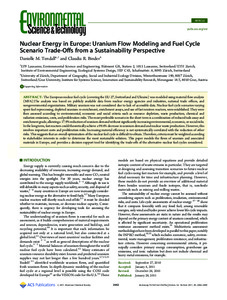Nuclear energy in Europe: uranium flow modeling and fuel cycle scenario trade-offs from a sustainability perspective

Tendall, Danielle M. ; Binder, Claudia R.
Environmental Science and Technology
2011
45
6
2442-2449
disposal of radioactive waste ; nuclear energy ; nuclear reactor ; sustainable development ; technological change ; uranium
EU countries ; Switzerland ; Ukraine
Energy
English
Bibliogr.
"The European nuclear fuel cycle (covering the EU-27, Switzerland and Ukraine) was modeled using material flow analysis (MFA).The analysis was based on publicly available data from nuclear energy agencies and industries, national trade offices, and nongovernmental organizations. Military uranium was not considered due to lack of accessible data. Nuclear fuel cycle scenarios varying spent fuel reprocessing, depleted uranium re-enrichment, enrichment assays, and use of fast neutron reactors, were established. They were then assessed according to environmental, economic and social criteria such as resource depletion, waste production, chemical and radiation emissions, costs, and proliferation risks. The most preferable scenario in the short term is a combination of reduced tails assay and enrichment grade, allowing a 17.9% reduction of uranium demand without significantly increasing environmental, economic, or social risks. In the long term, fast reactors could theoretically achieve a 99.4% decrease in uranium demand and nuclear waste production. However, this involves important costs and proliferation risks. Increasing material efficiency is not systematically correlated with the reduction of other risks. This suggests that an overall optimization of the nuclear fuel cycle is difficult to obtain. Therefore, criteria must be weighted according to stakeholder interests in order to determine the most sustainable solution. This paper models the flows of uranium and associated materials in Europe, and provides a decision support tool for identifying the trade-offs of the alternative nuclear fuel cycles considered."
Digital
The ETUI is co-funded by the European Union. Views and opinions expressed are however those of the author(s) only and do not necessarily reflect those of the European Union or the ETUI.